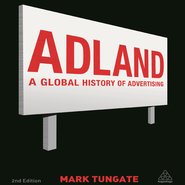By Mark Tungate
I flew in to New York clutching two books: The Hidden Persuaders, by Vance Packard (1957) and Madison Avenue, USA, by Martin Mayer (1958). The thing I liked most about them was that I had managed to get hold of the original editions – tattered ex-library copies with yellowing paper – so I was effectively taking them back to the street that inspired them.
One April afternoon I strode half the length of Madison Avenue, stopping occasionally to grab a coffee and leaf through their pages. At the beginning of the Packard book there was a note scrawled in blue ink: New York, Xmas 1960. It may have been the perfect time and place to work in advertising.
Mayer’s book informs us that Madison Avenue is “the only major New York street named after a president of the United States.” The author concedes that “the stretch that has made the street famous takes up one-fifth of its length, beginning at about 200 Madison and ending at about 650 ... forming what the vulgar call ad alley or ulcer gulch ...’”
At the time that Mayer wrote his book, the agencies on Madison Avenue controlled half of the total expenditure on advertising in the United States, while most of the rest was handled by their branch offices.
Madison Avenue had been the unofficial home of the advertising business since before the war, but in the past few years an unprecedented building boom had turned it into a glistening canyon of communications firms.
“Madison Avenue as it appears today is impressively new,” writes Mayer in 1958. “More than a dozen new office buildings, each more than 20 stories high, have been built since the war ...”
And what was it like inside these monolithic agencies? Having done the tour, Mayer could tell us that the offices of Young & Rubicam were predominantly decorated in green.
McCann-Erickson featured “restful pastels,” but J. Walter Thompson was “a class in itself.”
The agency’s stylishness had clearly not waned since the 1930s, and we rediscover with a sense of warm familiarity the dining suite “decorated like a New England colonial farmhouse.” The stylish Barcelona chairs by Mies van der Rohe may have been a more recent touch, however.
Madison Avenue symbolized the U.S. advertising industry.

When I interviewed him in 2006 (sadly, he passed away the following year), Phil Dusenberry, the former vice-chairman of BBDO, who came to work on the street as a young copywriter in the early 1960s, confirmed: ”Like Hollywood, it became an idea rather than a physical place. You could say that Madison Avenue was advertising.”
By the 1950s, advertising was considered a glamorous – if still not exactly honorable – profession. Attitudes to the industry at the time are personified by the Cary Grant character in Hitchcock’s North by Northwest (1959), a dapper Madison Avenue man who is mistaken for a spy.
Towards the beginning of the film, Grant says to his secretary, “In the world of advertising there’s no such thing as a lie. There’s only the expedient exaggeration.”
An entire mythology formed around the advertising business during this period. The standard template for a New York advertising executive was The Man in the Gray Flannel Suit, the titular figure of Sloan Wilson’s 1955 novel, who actually worked in public relations.
If admen had ever worn flannel suits before the book became a bestseller, they certainly avoided them afterwards – although they were paid handsomely enough to be well dressed. They were also known to work hard – often ridiculously so, until the early hours of the morning – hence all the talk of ulcers and heart disease in the profession. They fought stress with alcohol, giving rise to the “three-martini lunch.” This actually existed, according to Phil Dusenberry: “Taking a break for lunch, particularly if you were with a client, wasn’t a big deal in those days.”
Mark Tungate is a British journalist and author based in Paris, his specializing in media, branding, travel and lifestyle trends. Reach him at [email protected].
Extract taken from Chapter 3 “Madison Avenue aristocracy” of Adland: A Global History of Advertising, by Mark Tungate. Second edition published by Kogan Page, July 2013, RRP: £24.99
{"ct":"13j2QpyLovsEC1cXQoYqk9qaaVKythw4mukCbfAhQjre6PXp\/cp5pAH6HAa8Rjx9TalgYHIJVJ4TEthfuGPOh2DBd8C4Epj7\/As\/JEmf6xJpbTWGkHQOW3IDlALkssWdYj0vOGNNUf6JXaAUwoZswO1q21KCM2FLbflUCRBd2HYuWYsSUbh6+LDiSIGtCw\/C+BC1nWw7CNcLEILkCAfpaJnuXhCMuI9m0qatlkbV9SDq8DdbO7JnQqn\/yjkEbYec8CPPSNFywBIG2Z79C5NXg63C8Vly0\/NrfhivHX76IEvg6twXvlQbNbDUgmdckt0Ku7LwlMkH39CxdLYRNlU5SLf\/7SQJu3Ks8JB\/G1nXMg5m2D+XX5lZWKtl0wD+iLhBdZuytFHddq1rR\/82CHGn3kVOMNDOzl9wqChbw3r2U1kY357KZbZl7xN4uyspcidDp2mZply0sf489X3INb408YPxkM2RjQWid2m0wZ\/MOerFhuP\/twrl0AAErsseAyq8uW5f3ysoYuP+CUgm0m\/cYHWMaP+QxnCIqBYY5+RYFfY8UM4Pe1flw4YM4YldGNwbzEcdeqHtyy7RGBYvlr7c1ldljXRNcNEz1TniDxD1VX2jUSLMOqoIGX\/U+fiWsgLrBL25P88p2xKgwjJm9odj6VBWkL9tOM0SECsFfNfK9wyu66CSs+hrmm\/79+RwhcI+8XJDeUHm8eX6834DYSU4f6GNxqLnobubkaBWnSuPxql\/AJL2ECRAbPuaWmqqCRTwPCcdjk5l07lxGfUxRVyMRbaCcLAmOk4Md05t8ms4zEmn8Q6cXvZ0\/4s0pMIGllGEoOyMoB9Gq0crE5fov8aih+EkQs+vq6Go8YD4+r5p+\/9FEKzUV0\/yAe+JmGSY0ynbxuQyq11PtVtSEMljtxm6i6zgfHumjrgePKnCdxlZinx3eQFh3NL69oeSOzMuF0yQFyMiIOx4ovp1fYQiR2UWnfST3zopDME0E2gQuZcFDq1uanbb\/RrikgbLCTNcCu4M0e+vmEQGbxqgscBZ1L2ucblwun56nMwZhXupvLAouvAsrYRjdWOoF4I\/k413wO\/PZ16xY3blW\/sVBrQAA3OakwvilLlCnxw3MPI5q3veuB42Nwl1V3fBB5A563gHkz\/HK5BvU7R\/dy4lU24MjXRLQzKOUzDthJthrNaAajb8LOSVxajN\/sNpSsQmrzg1UDZDlZoEqRugOQ81HtDL6iyqc\/hjOOby\/Kbp4UL3U2r0yfti\/6lUzGApeeVfsnLFAkMgJgseCHr2uvaXTEEdqkdOmMej9aYlOmdBoIztE1JkDXE\/NRH3csQELy5ND\/KfzxFp\/v8BncLBPvNAfRjsIWvZshqYkAYS8l5433+t7f2eXtOFG40i9a7miIfJx6FwlgYuj+TpcRmUO7H6zGOhzFQic3wh6xogtrbxGN8MlXmeIahMUZ6Y4noRJHH7fxZGyJLUfyawABt88ayv7gOkU6QaQ4C6Offnl0OsvK+8HTkBoknSemujQ1PcQ0wQj2SyjDXOK1y9bRY908dscsmMhAjq+pRPqEw5Dm2RcEHvcleyLp8HBilQVg4IXSIYhgE9x5Jlx93lr56PyexwbdAS7GlWbDlizpVc3aowVNow2IDXIO7hTZ\/fSEVxQzd15W1yaRt03Gz37I6+ys47Vlcb3x2GUBTl+dmSldxc4zu\/1r7vugRs7\/SEgaxm9gj+DWveNjHaQJlTY6imV3tGZseWoz9TDH011kEItx8nxBWhkKdBOI\/OsV6kkH7bCSuxXeQ6wjg7gQMR9LzBp3q1DEtgKLjkldpudtaF9\/SU+Xmy4meD38\/hQAXjyB0jyDBMR8VbN9W+OvF1V3xB59lT14c3+OQZNKLqqQ0BC7R\/KJyaXhGnatG836Je\/w31w4Etft0n\/ec5ZsJLPCUQGcRpJKL3+HLfxJBTnf0OqGb15p16tZ1BcF1PhWvH9AsKxOo7r7aHIV08y\/yZfnQGlYO2Tn9vQMNbXTwisKkinH+wQZoeFGf1nmHFMoXV3+wIj\/OEWpaTNaENXos2fFOIX9+78bIpCBOmxDKGk5h5jCnB6HkaX+8YytCdDhV5gxEbv94+mPb5hjFqzhWLTVJRWqaA8HKKOUQAQj0yw94emXtyGEFxdE5SZs0Un9tgMDhzjXtvrAQhYtN5xuAh67nS0tDR\/5jXQfowxeUj9KAUp0RoEp\/5fbvm1l3xrHL758urRR6F+bzFTgttpEPBlNpK3YmTAEkWrgiw5zftFf4yeJ3Yn9Jxoz2hKe99FHI\/cIchpwmkepRjcvQcraGcdLwMbWTMbkiacicRx\/9g8bh0ekUl6ppx97REA0PPtwgFDj35+2PnYVzzXLNXLqcLSPH12ZE\/vjYWb1qyosbhMq4AD9ps4pfhq9bKwqfC7Kj3e4fzbLgzS4NxLhu5kmph5gyplpU+XFhVGr3SHC029Rl39+xm75xQIsPmQ+tW+c+2Xqj2cMsqgdoFOoTysRzRKdyZc8BfRLnFMz2CObQFYbL7sOiHoU9OzvATKPUnLN1rV8i29fUHd9gJ1I3gvZjq3QQK+N3UU4sHOZp8F6eQWqmqlzFD74oUfxVscnd8UzD61qnMJi6uFwY3hl2vkaTALC57XE69EgVeBGUv+WyLaSAsdjI\/Grpd1bfgattJj\/5JV1qi0G48CsgypYxBHQHAeUAwmy8lIU20IL2RkH5lYiJPw1U6lOO4IWTkD0Xoc2IELHA3iudx3gf5noLBrqGP09JYS8+SvTCrS+qOVAD6+x7IF2SEBTH6Zz8Lj52JzE4hQl2KTNF1duGjOoBfLuFKbpgY6\/oYcOshEMkNaoHYLPEzEZH5jaRnVrl1wX79jxavBPq1xsuyEdcZ4ByawRb9K4LvGKflW\/blToKWl3dMQxePzHF3NvquSAIatm\/\/sIvwd6++bm5ijzg026YYUj5Txl5Xc1ZAr3ghwwZ\/v+rF1Y65vrmaz7TTlcbr198WwMCS9c1MpBoMw8HOFYFUqAqVdedE0usxg37rp9YOBJQC9KwkdoJzge9RKoahu4Pm\/ngkkYvHac+tdHyuuwXq4bVDzp3Mflx+GBhQbodfC8M1ItPOBaoQSzkIJA0ZLGowoS54PJq31e1U0boTkyDtIlfUdiJKB\/Mb1rA6j2KfrZMOGphLmCkWYUp\/BIndU2LEDW2oFW50oTp8j8+jzYr5FSCvyUQwPbyNKVYn3pcIz3tmxBrh+SLp0YLc33VNV1nyNq4xQYe9mZOfJzZzcxX1syWiU2cmMMuMEEGy+6+9gDMWi1RLNFLCHoBX7UWQQP3ze2YIOlWK1GHaV33A7sHpFjSL50\/lNue8hyxsO5mWEnp2mpLCf4x6egMlW08Kh5\/GptgNlOxkrN4TpCZdMeJj+SO9y0CPhEXHZat6dIteniiIP4DSARYMLHPRdCGsxe1TzC6jg5NSLRieiNA5fq8AEGoASjAtFxX9YmsyuZVQlvDaLHb2vCXqil3eKXczymS2q3mz5Cd0DHce1dvAQgrTs6RLBc6AIuMvlFBykRBRY1xOwkN0RwHoW4vnAJFK\/gjgOqUxGi\/NAlMKDzyORsvFstP1lUevBbimrXMo5Bg7Uq3Qt39tCMw09+4Lu8Gw+9b9wlfjVUWBzPYJk4T6lqx2LjppfKGabg88mcvAeOZwe\/I49CcV6A3pNztUB1TIBK7SEf5hdtHm+GnmA4iLaMnA\/y6hp3hQMtE\/Clp4YEpHgq7J7hA6\/+1p+9rFyUG2+7xEV5EoQpMK8k3DgJ5MAE1wvsW0Tw0b7RzwREdE3Zm+imC2nQOXLmiA\/Ol\/VdPTkdvBYeENWJFfdasR8cPPnFlUws7EcZL\/7t2wmNseSgNwpVq3+KI1FP\/7\/gMGEr7ee8OlUr\/bcQjulFA1MLmn4bLEI0UTZix4B+KCt1jnmv4Gpl3AsQLM8EPpMHgbw2HkFUESyP3FpMbNt1TKPLW0NTP474fSYUEvnFr+Aqy20eBIXcdaw0gzzk3q5PQzStmEPLz4KAvkTB5X9hquMTQ+m+SqEuBwFXeUEhpa16MMBUQ214XSzH6g\/w5OO20\/QhW+bZK7fdGeI0mpMWDBlf6nSS4I6kjsoSiyTuWspEkgChGrJ24ESzJB\/MXaP24cn\/j2yvkwixqct2LfmHId4xLdGWb3b\/HPmZKr92Z+BJ\/xdHjl6X7QLQiE5EObuLrlYWcYkv57mckN+pW3E+kwUANHhRpeGntOplptIbedgRO2ntZPltQ2+\/RT2HHwaPfRWYMfHKcWCFQkTfMxew969FVi2FST6VrIxc3tnGkSfmdWAcv26Ft8uBIpvbogDzRESobPgL74n4jau2l4tftkr435FEbkEF0xT9FFW\/LZ74wHlYWH67FazUz9iitjhryzTN4n3Iziyrk8IQnRNEBrVu+CyWty4hYo2ldLhjPv2FD5unXFxdcLCoAfwLT9Chga0xwgXjK3FfP0C3TPNCK2YqYgaaKIZbkvqmq\/y6+YgIBopTMHgjq0ukLA6WAnOHm5HhZozLBEGDr5wTRYEoIeDkiw7QhJqsvIBv1UgbcT7geqktsgV2x73hslW4KSHdmQYKS1enyKCyj8iJktSmD7jrE3gH2xcasQzc+poUIWLZhaOF33A4\/gwD+9MD9smFDyhr1Eogh6gm9v3mq3QVLKFwiTxvNOYe42TvzUfyIPln2Ack7Biam7COlYLBby+n6ChhiyHU7\/cC2DkaCWMNE07ZplVjaU6SHIwHXnrugQkdzH0EgGG73xYz7Zjanj8MGqvaeqFxncUbFbkxFgVWDCKbtlFbEewBofaaJu0wdRjleVzCoS2MBXTe2\/yu51U80rae7Mdv6r8nHbAYUWgSSHfrsitjhpVCekPEGgM6qtvALluiK\/Q\/NgbqAlOIeTwrLIl5yJJuJ3axWOuJbemt+p76ud2m0N3+h5UwT97V\/Uxduxwh9I8NR7H+pK6a\/\/VuOnwjg2sxq4tzfFq7LW0ektY\/+jFxkLWszBl3gzm4XxlwW\/IsdXBTkERDfiI+p8VlnhD9sO2BgIQPevMw9z5AYU3dwM0B\/mTojcBRNPK17JICOlZofYs\/RRiCbkZMPlZwk44V1FnZ9Kn4+oC3BLN63RnYSF7h8G9ALWO0vb2K1DiBd5tJhqf+geieHwv\/mxXYf4w4Si7+dgHacHK5nUWBDGW8M4nK78D7idxh3N9pRaX10OD3fjHiSbdKcST2uIQLpLoF2Q6nvTE\/wrK8aHZ\/g1C0WLFyGHVTM7pUmz932IRJIiyhwYJfS7o5j0IXUr2OievgyWJoFUu1YqrK+66dHUHz8EscpRV2RZ\/+dnOT1Lbks51S3JCTeucW5Ivy9ukSTkiSZ7GkzHMwo4ObDjAgJycXvZZGe\/ecw1p7vArYybKwQgMYPHMqyfoHkEZrcJ+0rl\/UwD4TTdN8413CgwPWp73\/dWATTkcZSQv9YIfUFXXwtOWnPm+qW2\/I9oU7r2XfpLEBvick1Q8wyE+6kUyOgxxpYRXp4DnWJ0Ub0zwgVfSiDEpGBDFpVGqOhZim9BuWCFhADMHdrhhiOxAqOfB0siGFxBpYS0h+axDKTST7WsW2wkyNe0t5r+oIp6rjYO7+0Foz18b4FQmviEDgdiZfz31r1AQW5Ug3mwi\/NjYy5naugHJtHeeJi2kfpQmtmhaAT+HBa2pIh9OlUDsqjUwnvNLajT9a4DDmJ3\/iG6mwVJl+NSAAnHvgY2\/\/rp+0GkA6T8vvc5fuUrNHbdZgItSmGacfk2cEWhPMnOnBl6EZsAUrIBibZVS50ROCEUZzbqTcmC3aybp\/ZCBDlrGC6nt66DzvjbkPuZE9W4F+CbeAmMGT6pE4vXYlzLLxIqy9bRuLWbWrNojWERZ9fIfO\/lYu9kPQdW5cWMF9rPtQT6bgWmy5JHd9F0ZbqfAltZNWeK\/ZQgWPRrYKJcJxw1mIw+BRrnL4ohglxgQs4sjD\/dgcm7cMp\/ru44Qlm3gSUHyndLeGx6HYEKtLm66KY8M4Osw\/4t2ZYT68yMxAqtxssb\/tFQKD2ZmTnXJdtENsYBqE4A6gvOpHqbywVMJxM3fo9HsTFhbWkWimwQ5x2lKVjq8+fsiKJJm+G1VDkfhKUhTKVebT9zKqYlo9WeeLqglT6v3NM1Fl3Lx4GYDp0C3pHnOQr0hmzfxWc2T1M1eCF5CBk2xaLXTnbT0Is+K1vex3SjsrccVx3gPx8nRBAqxaK\/Fl3zRRxQS9coZT7WDX6FORkFXxek2WwPR6nAgsF5cOMvc5Ct3Op0VnoP+sKUWyUKgLZ6PzwFWp6Q0JZVjXnObYy\/laJlyoelKHVJUposKBVgJ2aKzGGp77efXhzE2N23tDasls\/38kKf0UjWN338Pe6pTZ2+Vc2svJzjhr0po4skJvtq+1ZRkeWhZb\/E\/ae1n+eN\/wYRu0PRQCgQGa\/VUbzvH6Rb371olOeLkHAyIWz5qZmVtb9z+px8KB52vigATHauxC4bHyMWe+YDdd9CiPX98XtunFfxIchartaJbazDLsd6yWT9gDpojk8Uez9Nng8OCbSyRw\/\/qa1W3fBqOkmH+BnH8n8zJAY39XDmcA16PRqhVmh8Lpmxs49dmAVyLma9dbSGiPvSeTM+Pbw6kapcG81oi6KBvGAmUZhbi82YJtFcruWTEHVImaUOinW7yZ\/HKIGJZVLuxQ56vwNw+3haKKo\/ZFbksJjrq9M+u+elvgA2az1hwXK\/EwM\/UFXM+OEfxy4iYXhNJCc\/qUgAptnse4nq1aa8MX7FxbtoeTrxRsGzH3WfqiTrPnCXmePpblvhjp+pb5W9crzZG5fu7EQs8RF\/CPBHpEdueO6KqzaIwSEp0n9pOoALC8cR7KcGXC+UemJhWXuMMFDbP8OdD5+htuKzoSLV2jIAX4YfQ0\/hgUFuTyNVWnbv2Zz34H1rcVCkztIwvkue4+w9tKkfOCAEGrYl+2lP95gJSA8hhpiUS52h05+ELAXZpJ7qUUoFub\/QI0ZD0K3R7sFGdrLf8B5k1X+D2ykEUXAuoCg2CQDBq6GWYryPkvx1a6ZDn8LPP5CgnDsgQk4+ww6SU0GYZvCXjlTIjO7gkbu\/gkTn3+w3a3Wu09i8Lvpu+baoRRSeE5AFGr0E5dsFTv0\/KrVgeBk5eQ8hVXXQVuaOCqFZx+L7VZ\/Z57mW48e2gwQBdT\/VpyUu3yG1gKy6pCwymcPIAYCLy87SJYoms1d86ttI5L+GaD9v7uLlGGR+OiKOXa1q6auqXr2eqlSJSwxtbVv2QPL1U1EvffhhmzVpTAtpWInzEnxdjK959Xs\/sRDK1xjX2OwWzK38KGToQ9Q8zur2VVvDih4A\/cHdbY8TARPuwL5XYjJ9yV3+C5Zy","iv":"d068d3a1e545a284ada80c0f4820589e","s":"993eff1daad75fa9"}
